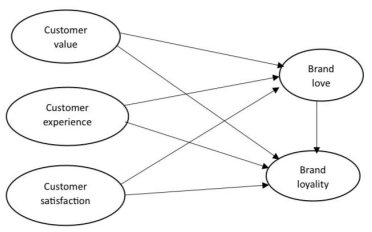
Submission to VIJ 2024-05-06
Keywords
- customer value,
- customer experience,
- customer satisfaction,
- brand love,
- brand loyalty
Copyright (c) 2024 Alivia Andini, Meylani Tuti

This work is licensed under a Creative Commons Attribution 4.0 International License.
Abstract
The purpose of this study is to ascertain how customer value, customer satisfaction, and customer experience relate to brand love and brand loyalty. The research population comprises Starbucks customers as of December 2023. Purposive sampling, which involved selecting customers who had made purchases more than twice, was the sample strategy employed. A total of 250 people's data were gathered. SEM is the data analysis technique employed in this study with Smart PLS assistance. The study's findings indicate that brand love is influenced by customer value, customer satisfaction, and customer experience. Brand loyalty affects the brand. Brand loyalty is unaffected by customer value, customer satisfaction, or customer experience. According to these findings, a brand that is well-regarded by consumers would offer positive value on the presumption that the product or service fulfills their needs and gives them a satisfying experience. This will lead to customer love for the brand but not brand loyalty.
References
- Aaker, D. (1991). Managing Brand Equity. The Free Press.
- Albert, N., & Merunka, D. (2013). The role of brand love in consumer-brand relationships. Journal of Consumer Marketing, 30(3), 258–266. https://doi.org/10.1108/07363761311328928
- Albert, N., Merunka, D., & Marseille, E. (2014). The Feeling of Love Toward a Brand : Concept and Measurement The Feeling of Love Toward a Brand : Concept and Measurement. January 2009.
- Batra, R., Ahuvia, A., & Bagozzi, R. P. (2012). Brand love. Journal of Marketing, 76(2), 1–16. https://doi.org/10.1509/jm.09.0339
- Carroll, B. A., & Ahuvia, A. C. (2006). Some antecedents and outcomes of brand love. Marketing Letters,17(2), 79–89. https://doi.org/10.1007/s11002-006-4219-2
- De Ruyter, K., & Bloemer, J. (1999). Customer loyalty in extended service settings: The interaction between satisfaction, value attainment and positive mood. International Journal of Service Industry Management, 10(3), 320–336. https://doi.org/10.1108/09564239910276917
- Erkmen, E., & Hancer, M. (2019). Building brand relationship for restaurants: An examination of other customers, brand image, trust, and restaurant attributes. International Journal of Contemporary Hospitality Management, 31(3), 1469–1487. https://doi.org/10.1108/IJCHM-08-2017-0516
- Fornell, C., & Larcker, D. F. (1981). Evaluating Structural Equation Models with Unobservable Variables and Measurement Error. Journal of Marketing Researchh, 18(1), 39–50.
- Fournier, S. (1998a). Consumers and their brands: Developing relationship theory in consumer research. Journal of Consumer Research, 24(4), 343–373. https://doi.org/10.1086/209515
- Fournier, S. (1998b). Consumers and Their Brands Developing. Journal of Consumer Research, 24(4), 343–353.
- Ghafoor, M. M., Iqbal, H. K., Tariq, U., & Murtaza, F. (2020). The Impact of Customer Satisfaction, Brand Image on Brand Love and Brand Loyalty. Journal of Advanced Research in Dynamical and Control Systems, 12(06), 3151–3159.
- Griffin, J. (2016). customer loyality : how to earn it, how to keep it.
- Gultekin, B., & Turgut, M. U. (2015). The Critical Role of Brand Love in Clothing Brands. Pressacademia, 4(1), 126–126. https://doi.org/10.17261/pressacademia.201519963
- Gummerus, J., Liljander, V., Weman, E., & Pihlström, M. (2012). Customer engagement in a Facebook brand community. In Management Research Review (Vol. 35, Issue 9). https://doi.org/10.1108/01409171211256578
- Han, H., Nguyen, H. N., Song, H., Chua, B. L., Lee, S., & Kim, W. (2018). Drivers of brand loyalty in the chain coffee shop industry. International Journal of Hospitality Management, 72(January 2017), 86–97. https://doi.org/10.1016/j.ijhm.2017.12.011
- Hawkins, D. I., & Mothersbaugh, D. L. (2010). Consumer behaviour: Building marketing strategies. In McGraw-Hill.
- Jacoby, J., & Kyner, D. B. (1973). Brand Loyalty vs. Repeat Purchasing Behavior. Journal of Marketing Research, 10(1), 1. https://doi.org/10.2307/3149402
- Khamwon, A., & Niyomsart, S. (2016). Brand Love, Brand Loyalty, and Word of Mouth: a Case of Airasia. Conference of the International Journal of Arts & Sciences, 09(October 2015), 263–268.
- Kotler, P., & Keller, kevin lane. (2009a). Marketing Management. In Journal of Chemical Information and Modeling (12th ed., Vol. 53, Issue 9).
- Kotler, P., & Keller, K. L. (2009b). Marketing Management. In Essentials of Management for Healthcare Professionals. https://doi.org/10.4324/9781315099200-17
- Kuikka, A., & Laukkanen, T. (2012). Brand loyalty and the role of hedonic value. Journal of Product and Brand Management, 21(7), 529–537. https://doi.org/10.1108/10610421211276277
- Lamb, C. W., Hair, J. F., Mcdaniel, C., Calhoun, J. W., Marquardt, N., Bryant, J., & Shirley, S. J. (2009). Charles W. Lamb.
- Lemke, F., Wilson, P. H., & Clark, P. M. (2010). What makes a great customer experience ?
- Mahajan, G. (2020). What is customer value and how can you create it? Journal of Creating Value, 6(1), 119–121.
- Oliver, R. L. (1999). whence consumer loyality ? 63(1999), 493–495.
- Oliver, R. L. (2008). Satisfaction : a behavioral perspective on the consumeR.
- Porter, M. E. (2020). Techniques for Analyzing. In Techniques for Analyzing. https://doi.org/10.1201/9781003067573
- Roy, S. K., Eshghi, A., & Sarkar, A. (2013). Antecedents and consequences of brand love. Journal of Brand Management, 20(4), 325–332. https://doi.org/10.1057/bm.2012.24
- Schmitt, B. (1999). Experiential Marketing Bernd Schmite ExperientialNiarketing. May 2013, 37–41.
- Sweeney, J. C., & Soutar, G. N. (2001). Consumer perceived value: The development of a multiple-item scale. Journal of Retailing, 77(2), 203–220. https://doi.org/10.1016/S0022-4359(01)00041-0
- Tuominen, P. (1991). Managing Brand Equity. Journal of Marketing, 56(2), 125.
